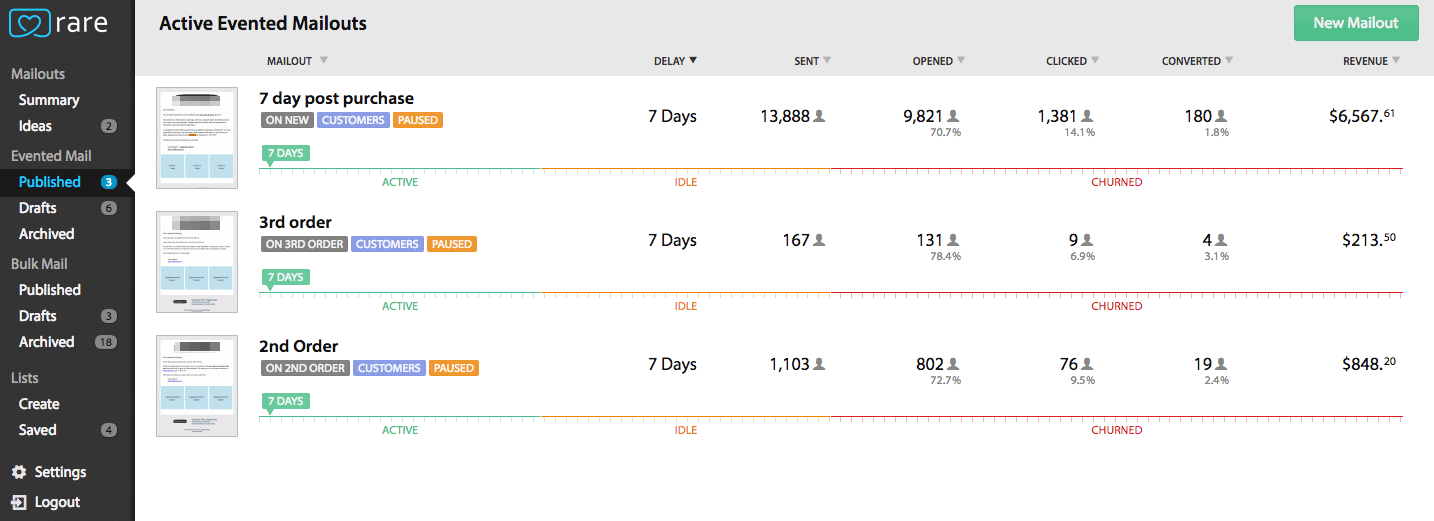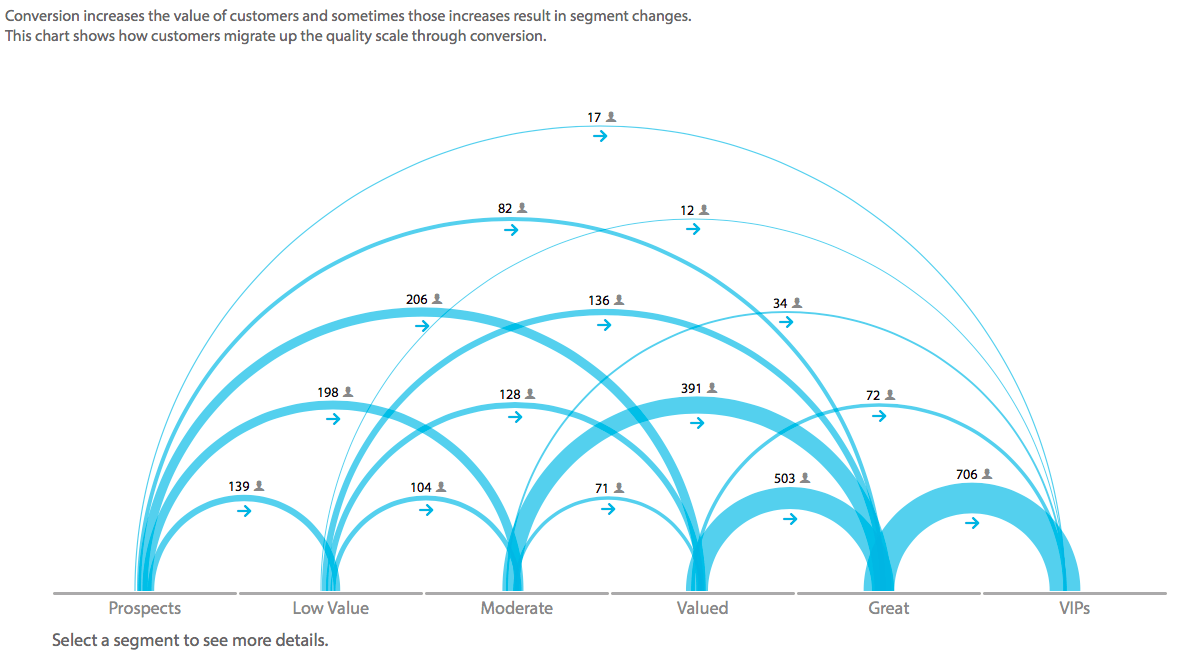
Right email, right time: A Q&A with Rare's Taylor Sicard
Email marketers have a lot of tools at their disposal. Some of these services pride themselves on sending billions of emails each month, while others provide a more crafted, intimate experience. For all of them, their core value has been helping people send bulk emails, manage subscriber lists, and track their results.
Rare, an Ottawa-based company, is trying to do things differently. From their offices just a few blocks from the Shopify headquarters, they’ve built a predictive analytics platform that lets merchants send their customers personalized marketing emails and product recommendations. The app, which is compatible with both Shopify and BigCommerce, uses customer data from merchants’ stores to help them tailor the timing and messaging of each email based on its recipient.
“Rare is a lot of things in one,” says Taylor Sicard, the company’s VP of Growth and Partnerships. “We give merchants the ability to send beautiful, easy-to-build emails that are targeted to the right people at the right times. We offer the same features as enterprise tools, only at a lower price point and with more functionality.”
We chatted with Taylor about Rare, email marketing, and what he thinks online merchants can do better to grow their businesses.
–
What are the some of the things Rare does to help merchants personalize their marketing emails and increase click-through rates?
One of the things we do with the data we collect from Shopify and BigCommerce is we make it easy for merchants to send emails to customers at the time of day when they’re most likely to shop. For example, I do most of my online shopping on Wednesday evenings between 8:30 and 9:30 pm, so the time of day that I get my emails is going to be different than most people. Time is also a big consideration when you have customers in different timezones and countries.
In terms of click-through rates, we have the ability to utilize predictive products based on a number of factors, including the customer's purchase history, the products that are currently in the merchant's store, and the correlation between products A and B, products A and C, and so on. We use our analytics engine to suggest the correct product for each customer, which encourages higher engagement with the email.
So the higher click-through is achieved by having the right product and messaging in front of the customer, and the higher open is tied to the timing of it?
Yes, because aside from timing the only other variable is the subject line. Subject lines are important, especially if it’s first thing in the morning and the customer has a hundred emails in their inbox—but we think it’s even more important to get that email in front of the customer at a time when they’re most ready to engage with it.

Can you talk a bit more about how targeted timing works? And some considerations a merchant might make when timing their emails?
We give merchants the option of sending their emails at a specific time or sending them over a period of 24 hours. With the 24-hour “best timing” method, each customer receives the email at the time of day when they’re most likely to shop on your website. We determine that time by analyzing their spending history and the time of day when they’re most often engaged, shopping and buying things.
The important thing is getting to customers when they have the ability to shop. If you schedule your emails with the best timing, it might take 24 hours to see the full results, but your open rates will be significantly higher. Between the predictive products and best timing Rare offers, we see between 300-500% higher open, click and conversion rates with customers moving from other email marketing platforms.
Is “best timing” solely informed by the individual customer and their purchase history? Or is there consideration given to industry and/or demographic research?
If you're using best timing, it's personalized on a customer by customer basis. I think it was MailChimp that said the best time and day to send an email is 11 a.m. on Tuesday. But you know what? My inbox is full at 11 a.m. on Tuesday. If I have 200 emails in my inbox, I’m going to mark all as read and hope I don’t miss an important one.
Everyone is different. Some people work 8 to 3, some people work overnights. What we look for are the commonalities between purchase patterns. We work under the assumption that humans are creatures of habit, and we use that information to hit each individual customer at the time of day when they’re most likely to be engaged.
What are some of the ways merchants can segment their customers?
We did one case study where we sent out an email and then sent another seven days later—the exact same email, only with a different subject line. With the second email, we targeted only people who hadn’t opened the first mailout. It was the exact same content, but because we knew the customers hadn’t opened the first email, if the new subject line caught their attention it was like free opens and free click-throughs for us, because we didn’t have to spend any more time doing anything.
That’s just one example. There are so many ways you can segment your customers, and so many different opportunities. If you have customers who spend over $1,000 on average in your store, you’ll want to message them differently than the customers who spend less than $50 per transaction. If you find a group of customers that only uses the free shipping coupon code, you're going to want to give those customers free shipping, because that affects whether they buy from you or not. And regionally, you might want to tailor your messaging and offers based on where your customers live.
From an analytics standpoint, a lot of stores use our interval chart which shows the days between the first and second order, and the second and third order. This is a great way of following your customers' natural buying habits. It’s exactly the type of data a store should be leveraging to make sure they target their customers correctly.

Have you found any industries where predictive email marketing is more effective than other industries?
The one I find thriving right now—and I spend a lot of time looking through our customer base, looking at the emails they’re sending—is consumables. We have a company we work with that sells beef jerky. They know that whatever size portion they sell, the customer is going to buy again 14 days later. That’s because it lasts 10 days, and then they have a couple days where they go without it, and then they crave it again.
Fashion and apparel is another big one. If you’re a store owner who understands your customer’s buying habits—if you know they work in an office and buy a new suit every year or every quarter, for example—then you can make sure you’re sending the right message at the right time.
I think it applies across every industry, really. Here you have two of the biggest buzzwords in tech—big data and predictive analytics—and you're bringing them into email, which is one of the few forms of advertising that is still skyrocketing. Email has been around a long time, and it's not going anywhere.
Does a solution like Rare play at all into subscription ecommerce?
Yes, it does. Our predictive recommendations won’t recommend things that were bought previously, but if you subscribe to a monthly beef jerky subscription, for example, and you’ve enjoyed the barbecue flavour, we might suggest you try the teriyaki. Or it could also be a one-off recommendation to try a sample of something.
What can merchants do to avoid losing customers to the unsubscribe button? Or are unsubscribes just part of email marketing and you have to accept it?
I think the biggest thing to note is that you earn the customer's email in the first place. Customers aren't obligated to give you their email. They can choose not to accept marketing if they don't want to. Every email you collect is a big opportunity as a store owner. I think the biggest way to avoid unsubscribes and losing people is by making sure you're sending them the right messaging.
With the way Rare does segmentation, you can get really granular. You can look at a single person and review through a timeline every email they've received, whether they opened, clicked or bought something from it, plus every purchase they've made, whether it came through email or they went to the website on their own. You're able to see and learn so much from that. If you're not utilizing different segments and the ability to narrow down your target audience, customers aren't going to be happy. Everybody wants to see a personalized message that is relevant to them.
It sounds like a powerful platform for getting to know your customers...
It is. We have a company we work with that sells gum. They sell different sizes, so you can buy one little pack with 12 pieces of gum, or you can get a multi-pack carton, or you can get multiple cartons. They target their audience based on the size of their last purchase. They know internally how many pieces of gum a person chews per day, and they have really good messaging. They send great emails to their customers, their customers love what they get, and they get them at the right time.
This idea of the right message to the right customer at the right time—that’s not really a secret in email marketing. It’s just been very difficult to do until now, because as humans we’re not mind readers. Even with all the data our customers are giving us, it’s hard to really analyze and understand it without the right solution. Luckily for Rare and for our users, all the analytics you see—none of that is special. If you have a Shopify or BigCommerce store, all you need to do is install the app and all that stuff gets uploaded immediately. There's nothing you need to export from your ecommerce platform, no extra lines of code you need to put in, no pixels you need to import. It’s easy.

Are there any ecommerce trends you're watching with particular interest?
I'm really excited for VR shopping. The ability to bring an in-store experience to your living room—trying things on, seeing how things look together. That’s amazing. I got to demo some VR at Shopify Unite a couple months ago and it also opened my eyes to the possibility of seeing a product in a certain setting. Buying a tent and experiencing it at the top of a mountain makes it a lot more real than seeing an image on a box.
What’s your best piece of advice for ecommerce merchants?
The number-one thing our team recommends to every single store is to re-engage with idle and churned customers. That means customers who haven’t purchased from your store in six or twelve months or longer. Keep these customers up to date on what you’re selling, if you have any special offers, any changes that your company has made. Keeping them in the loop ensures that you don't lose them forever. Because the longer they go without making another purchase, the more likely they are to disappear.
Head over to Rare's website to learn more about the app.